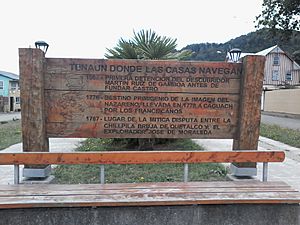Tenaún facts for kids
Tenaún is a small village in Chile. It is located on Chiloé Island, which is part of the Chiloé Archipelago. Tenaún is about 36 kilometers from Dalcahue and 54 kilometers from Castro.
A road built in 1950 connects Tenaún to the rest of the island. This helped the village become more connected. Tenaún was founded in the 18th century, making it one of the oldest places in Chiloé. It was an important stop for trading wood, especially larch. Many old houses in Tenaún are covered with larch wood.
The village is built along the coast. Its main features are the church, the town square, and the cemetery. These important spots are lined up from east to west.
The church of Tenaún was built in the mid-1800s. It stands at the end of the main street, facing the town square. This church is very impressive with its three towers. You can see it from far away, especially from the sea. In 1999, it became a National Historic Monument. Then, in 2000, UNESCO named it a World Heritage Site.
The long town square is another special part of Tenaún. It has two sides with unique buildings. These buildings show a clear line between the houses higher up on the hill and those closer to the sea.
One very old tradition here is the Minga. This is when people move houses, either by sea or by land. It is a big community event where everyone helps. The Minga helps people feel connected and proud of their Chilote identity.
History of Tenaún: A Village with Old Roots
The name Tenaún means "three hills" in the Mapuche Huilliche language. This was the language of the Huilliche people who lived here long ago.
Tenaún was founded in 1567. This was the year Spanish explorers, led by Martín Ruiz de Gamboa, settled on Chiloé Island. The village started as a place for traders. They would collect larch wood from the nearby Chauques Islands.
Tenaún still keeps its original look and feel. It is known for keeping Chilote traditions alive. Because of its cultural value, it was named a National Monument in 2004. This means it is a "Typical Zone" that shows the area's history.
In 2015, the Municipality of Dalcahue officially declared Tenaún an Urban Zone.
What to See in Tenaún: Unique Houses and Traditions
Tenaún is famous for its special houses. Some houses have a neo-colonial style with German influences. Others are covered with larch wood tiles.
Many of these larch-tiled houses were moved to Tenaún. They were brought by land or even by sea! This was done using the traditional Chilote system called the Minga. This special way of moving houses is why Tenaún is known as "the town where the houses sail."
The village church is called Nuestra Señora del Patrocinio. It is a National Monument (since 1999). In 2000, UNESCO declared it a World Heritage Site. It shares this honor with other churches on Chiloé. The church was built in 1837 by a Franciscan priest named Roberto Fernández. Later, it was updated in a neoclassical style. It has one main tower and two smaller towers on each side. These three towers might represent the "three hills" of Tenaún or the idea of the Holy Trinity.
Every summer, Tenaún hosts the "Meeting of the Cords of the Accordion." This is a very important event. The area is known for its talented musicians who play in this festival. There is also the "Week of Tenaún." For seven days, there are activities for everyone. Neighbors, tourists, and anyone interested can join in to celebrate Tenaún's anniversary.
See also
 In Spanish: Tenaún para niños
In Spanish: Tenaún para niños


